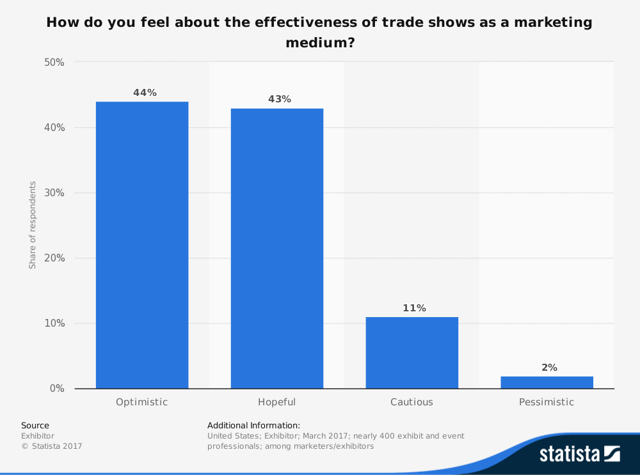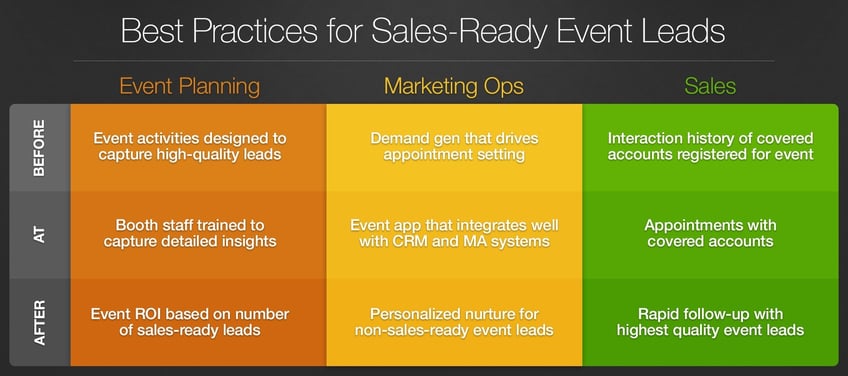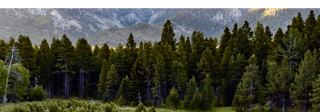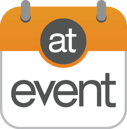It's the start of another new year and the decisions you make now will affect your entire year. One that often does not get as much attention as others are how to maximize the investment you make in trade show participation. Here are some informative and insightful data and trends that are being reported from events marketing decision makers this past year going into 2019.
Trade events are still considered to be a very cost-effective channel for successful companies creating digital marketing strategies for outdoor brands. How you get the most out of this spend should be a priority because a well-managed events budget could make the difference between an OK-year and a great year. As we enter 2019, it’s clear that companies are looking at their events spend and finding ways to maximize their events budget to find even more success in the events space, as well as with their customer engagement and retention. What are some of the reported challenges and opportunities?
- 75% of leads are never followed-up with after an exhibition (Source: The Marketing Donut).
- 14% of marketers plan to integrate marketing automation with their events, and only 7% currently do (Source: Capterra).
- 37% of event technology adopters are able to track the ROI for their events (Source:Harvard Business Review Analytic Services).
- On average, 33% of businesses determine event success by attendee engagement and satisfaction, 23% by the number of sales created or won, and only 14% by the number of leads (Source: Bizzabo Event Marketing 2019 Benchmarks and Trends).
Pick Up Some New Technology and Really Improve Your Spend on Trade Shows
After accounting for their sales costs, the costs of trade shows are one of their most significant line items in a brand's annual marketing budget. As the costs of trade shows continue to rise, to many managers, trade shows have become a medium, at best, a necessary evil, to be endured rather than exploited. When was the last time you accurately measured the success of an event, let alone proven positive ROI? Enter atEvent, “the most comprehensive Event Lead Automation Platform. (atEvent) connects pre-event, at event, and post-event prospect engagement to accelerate sales velocity.”
If attending trade shows is still a "must do" in your marketing program then you need a tool like atEvent. For example, this app allows you to plan, integrate data directly into your CRM, execute on site, deliver immediate personalized follow-up through segmented workflows, and calculate a "cost of lead acquisition" in real time. Regardless of how optimistic about the results you will achieve from participating in trade shows, if you are not collecting and tracking your lead data accurately, and if this data is not the determining factor for which events you attend as an exhibitor, you are not only missing the boat but possibly sinking it. It's the data and its use that determines whether your optimism was warranted or foolish.
While marketing automation remains a major priority for marketers, less than 20% indicated that they are fully integrating marketing automation into their current sales and marketing initiatives, including trade show events.
"In this age of digital marketing for outdoor brands where e-Commerce and dealer sales still co-exist, when a potentially attractive marketing tool offers face-to-face dealer contact coupled with the allure of increased sales, trade show staff should embrace sales enablement solutions like this automating app, even if not eagerly." - Kelley Wrede, Director of Marketing

To overcome these challenges, it is critical to measure your trade show effectiveness in terms of these types of objectives:
- The number of leads generated from a show
- The quantity of actual sales from these leads
- The cost per lead generated
- The feedback about the show subsequently given to you from the sales force
“Measurement is 100% dependent on your ability to plan and to execute,” — Erin Bohlin, Sirius Decisions Research Director
The reason ROI is often hard to prove can be narrowed down to three common pitfalls. They are:
Not Linking Event Goals to Outcomes
At the root of the problem are a failure to tie event planning, management, and execution strategies directly to the success criteria. If your goal is to accelerate existing leads through the pipeline, what systems have you set up to enable this? Tying the goals of your event to your measurement criteria is critical to successful sales enablement for outdoor companies.
Outdated Lead Capture Techniques
Even if an organization has keyed in on its event goals, they often use outdated methods of capturing lead information. Sales teams spend hours taking notes and manually inputting information into their marketing automation systems. This leads to a lack of appropriate follow-up and lead leakage, taking a toll on ROI. Automating the lead capture process allows the sales team to do what they do best: focus on their relationships.
Lack of Event Insight and Intelligence
How do you know what went well at an event, and what could go better next time? The best tools allow you to review trending topics and follow-up actions, cost per lead, covered account activity, and company user productivity—so you can make better decisions at the next event to optimize your ROI.
Enter atEvent, a Solution You Can Integrate Into Your CRM Today
atEvent was built on the idea that events should bring a wealth of qualified leads, not a load of technology headaches. They believe your event lead automation solution should be easy to use, easy to train, and flexible enough to cater to enterprise needs. It is all based on the alignment of using cutting-edge digital technology to easily capture trade show sales intelligence that allows you to execute a contact follow-up strategy to provide sales-ready leads.
Create a Strong Path from Event Planning to Sales
This scenario may seem like a far-off dream, but much of it can be accomplished today. The key? Event planning, marketing, and sales need to focus on pre-event, at-event, and post-event efforts that drive sales-ready leads.
Here’s what this alignment around sales-ready leads should look like:

Event sales intelligence is the currency of these efforts. From event planning to follow up, it provides marketing and sales the insights they need to move prospects down the sales path faster.
What Is Event Sales Intelligence?
Like its cousin in the marketing automation arena—sales intelligence—event sales intelligence is data that gives sales reps the insight they need to move the sales conversation forward. The event part is that this information is gathered at events.
Event sales intelligence might include:
- Designating visitors by type (dealer, media, rep, supplier, etc.)
- Using the topics (questions) tool to indicate the interest you want to track by category, by specific products, etc.
- Using the follow-up action(s) tool to immediately link the above information to a specific follow-up you want to take place (send certain information, follow-up call, set-up a meeting, place them in a nurturing campaign, etc.)
- Using the additional notes tool to record specific information not covered by the topics about the interaction you team had with each visitor they want to track
Here are Some Real World Use-Cases for atEvent
atEvent integrates with platforms like HubSpot. As a HubSpot user, I have found it works amazingly well. Here are some key examples of how you can integrate the atEvent app into your marketing efforts in an automated marketing platform like HubSpot to take full advantage of the tool (and full advantage of the leads gathered from trade shows):
Use-Case #1: Build smart lists that are automatically populated with leads synced over from a specific event.
How to do it in HubSpot: if you attended the “ABC Tradeshow”, you set up a HubSpot smart list ahead of time called “ABC Trade Show Leads” that enrolls contacts based off of an atEvent property and then also use this list for a workflow to set a custom HubSpot “Trade show” or “Lead Source” contact property for segmentation and attribution based off of the information synced over from atEvent. Eventually, if one of the leads attributed to that tradeshow from that list or tagged with that contact property become an opportunity and then have a closed deal associated with them in the sales pipeline, you can track revenue generated versus the cost of the lead from the tradeshow to gauge ROI.
Use-Case #2: Build nurturing workflows based off of topics and follow-up actions entered in for the tradeshow lead through atEvent
How to do it in HubSpot (using topics): if a pre-loaded topic your sales team talked to the lead at the trade show about and documented in atEvent was “What category of products are you interested in?” "What are the specific products in X category you are interested in adding?" or “What is currently your biggest in moving our products?”, then you would take that information and automatically enroll them into nurturing workflow sequences that addressed the products (services) they were interested in or the challenges they were facing.
How to do it in HubSpot (using follow-up actions): if the salesperson marked the lead as someone with a follow-up action “Ready to Book a Sales Meeting” instead of “Needs to be Enrolled in Nurturing Sequence”, a reminder task would automatically be set for the appropriate salesperson to follow up and book a meeting with that lead in the HubSpot CRM.
Use-Case #3: Help make the sales team’s job easier by automating the first couple of touches during and after the tradeshow
How to do it in HubSpot: after the lead was added into atEvent during the tradeshow, you could delay a workflow enrollment by 1 hour. At that time the contact would be sent a simple follow-up email letting the lead know that the salesperson really enjoyed speaking with them and hoped that they would enjoy the rest of their time at the tradeshow that week. That way, the lead would still remember who the person was and what they talked about and could stay top of mind since they were still at the tradeshow and had just spoken a mere hour ago. They would then get enrolled in whatever the next step would be based on of the follow-up action the salesperson indicated for timely and effective nurturing or follow-up after the tradeshow.
As marketers, business owners, sales professionals, and tradeshow attendees, we’re all trying to find ways to make our jobs easier, be more successful at what we do, and make more money. Integrating a tool like atEvent with your marketing platform and CRM will make your tradeshow efforts more worthwhile, which allows you to do all three.
What Can You Expect to Achieve by Using the Right Tech at Trade Shows?
- The average business saves 223 hours each year by using event software (Source: Bizzabo Event Marketing 2019 Benchmarks and Trends).
- 60% of event planners report that event apps to increase attendee engagement (Source: State of Mobile Event Technology Report).
- 63% of marketers that have event software do NOT have trouble proving event ROI (Source: Bizzabo Event Marketing 2019 Benchmarks and Trends).
- $7,500 is the median increase in event technology budget for 2019 (Source: Bizzabo Event Marketing 2019 Benchmarks and Trends).
- 90% of event technology adopters consider themselves well-positioned for future success (Source: Harvard Business Review Analytic Services).
The outdoor industry continues to spend significant dollars on participating in trade shows that have historically provided the primary avenue for moving products through retail dealers. Even though the landscape in which consumers are purchasing products is undergoing shifts away from buying through traditional retailers, they still hold an important place for many outdoor brands.
In this landscape, outdoor brands must be even more vigilant in making sure they are getting a return on their trade show investment. Utilizing new technology that integrates directly into the company's CRM and provides a means for automated marketing is a tool worth investigating. Although change is always challenging, getting your team to start leveraging event apps that are fully integrated with your preferred CRM and marketing automation tools is critical to improving trade show ROI. The atEvent app will allow your trade show team to capture critical prospect intelligence, and then quickly and easily close leads once the event is over.



